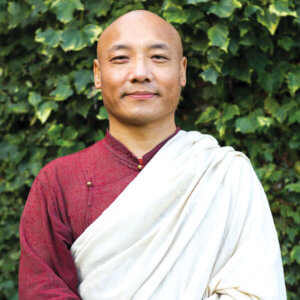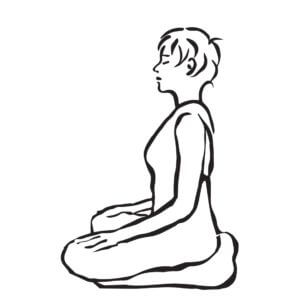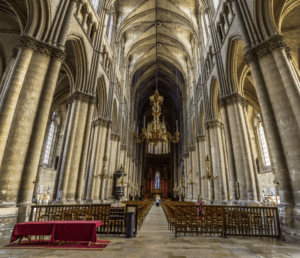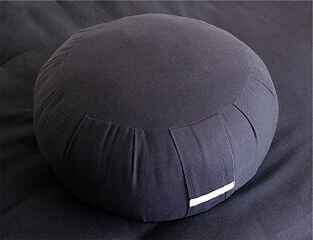What follows is the entire chapter on meditation from Anam Thubten's No Self, No Problem


$17.95 - Paperback
$16.95 - Paperback
One time Buddha said, “I am beyond coming and going.” This was the most profound teaching that he ever gave. What he meant was that everything is an illusion. That is the truth whether our mind can digest that as truth or not. Even Buddha himself is an illusion. In the same way, when we look into our consciousness we see that our mind is always telling us all kinds of stories. Everything we believe to be reality is nothing more than stories. “I was born in 1950 or 1960. I went to such and such college. I married. I divorced. I had children. I did this and that. I met with a great teacher two years ago and I found the path to liberation.” It’s all a story, all an illusion, imagination, fiction. The truth is that nothing is happening. Therefore we have to make sure that this, the egoic mind, is not just chasing after illusions again.
You may have noticed that we have a tremendous sense of fear and resistance when we believe that we are losing something. We always lose in our lives. We lose our loved ones. We lose our jobs. Sometimes we lose love from other people and sometimes we lose our fantasies. We are constantly losing. Eventually we lose this body too. We lose this entire universe when we lose this body. This is called “death.” Whether we can accept it or not, the truth is that sooner or later we are going to lose everything when we die without any choice. No matter how beautiful our illusions are, they are all illusions.
The beautiful illusion that is unfolding right now will soon be lost. There is not even one single illusion that we can hold on to forever. We are going to lose everything sooner or later. The sense that it will last is only our mind telling us stories. Illusions are unreal. Illusions are mental projections. They don’t have any concrete or inherent reality. When we look, we see that the egoic mind is always perpetuating its tendency to search for illusions, all kinds of illusions. It has done this for many lifetimes.

Realization is the heart of inner awakening. Without that there is no freedom. There is no liberation. Even though we think that we are transforming and that we are getting somewhere, actually we are just having another spiritual high, another spiritual illusion. The truth is that no transformation happens without this realization. So the real question is how can we realize the truth? How can we realize that everything is nothing but illusions, especially when we feel that our suffering is very real? How can we realize that all of the negativities and unwanted conditions such as illness are simply illusions? It is also not always easy to realize that everything is an illusion when we are having a good time.
Sometimes after we meditate we have a glimpse of this truth that everything is an illusion. But when we get off of our cushion and begin to deal with everyday life it is very easy to lose that realization. Sometimes this egoic mind has a tendency to work very hard trying to get somewhere, trying to realize the truth right now. It sounds very good, especially since I have been saying that this realization is the source of freedom. The ego will tell us, “This is good, I’m going to go after spiritual realization. I am going to do everything I can in order to get that as a spiritual reward.” The ego will tell us to search for more knowledge, more esoteric knowledge, more training, and more spiritual complexity. Ego will tell us that the more complicated the spiritual information is and the more difficult the techniques are, the more profound they are. Ego tells us that the harder it is, the better it is. The more nonsense, the more mumbo jumbo there is, the more sacred it is. And therefore our ego sometimes becomes a workaholic, trying to figure out various spiritual training methods and gathering all of this conceptual information. Then it thinks, “Oh, I am really getting somewhere now because I am paying my dues. I am working hard.” But the truth is that it never works that way. Sometimes these spiritual complexities and disciplines can be a hindrance, blinding our consciousness from realizing what is already there.
The Indian mystic Kabir figured out these ego games a long time ago. He pointed out these perilous traps to those who were practicing various spiritual disciplines. He said in one of his poems, “The spiritual athlete often changes the color of his clothes while his mind remains gray and loveless.”
So we might like to ask the question, “What is the perfect path to awakening?” Of course there is no “perfect way” or no “only way” to the path of awakening. I always like to remember the image of Buddha Shakyamuni sitting for six years. This led him to awakening. Therefore, sometimes the best thing that we can do is simply just rest and relax. Ego may tell us, “That’s too simple. Spirituality cannot be simply relaxing. There must be something more than that.” But actually, ultimately it’s all about relaxing. Therefore many Buddhist masters define meditation as the art of resting or the art of relaxing.
When we relax completely we see that all of our thoughts start to dissipate. The egoic mind begins to dissolve automatically. The egoic mind is very powerful and if we try to get rid of it, it doesn’t really work. But when we just sit and relax it dissolves without doing anything.
Somehow we have the idea that the ego is the troublemaker. Especially if we are Buddhist we may believe that the ego is the troublemaker. We have names for the ego like Mara, which means the cosmic devil. That is the worst name you can give to anybody and that is the name given to the ego. Because we have been criticizing and bashing the ego all of these years, we think that we have to fight against it, resist it, and transcend it. The truth is that the more we try to transcend the ego the stronger it becomes. It’s just like when you tell somebody not to think about a monkey. They end up having to think about a monkey. Therefore, sometimes it’s good to just let go of all of the effort of trying to conquer and get rid of the ego and just rest. It is so simple. Everybody knows how to rest.
This kind of message is not really a new message. It’s a very old message, an age-old message. The message is that if we just rest in this natural state of consciousness, in this very present moment, then this awareness, the enlightened mind, often manifests spontaneously. Enlightenment happens unexpectedly, in the same way that we are often struck with wonder when we see whales jumping from the surface of the ocean. They take our breath away. Throughout the ages these kinds of experiences have often been experienced by meditators. This is frequently noted in the Buddhist tradition. The beauty of this is that it doesn’t require any special methodology or any special training. It often happens when we are least expecting it. Inner rest is the sacred ground on which we meet the light of enlightenment. This knowledge is inherent in all of us. That fact is indicated by the beautiful Buddhist metaphor of a hopeless, exhausted traveler who has suddenly and unexpectedly found soothing shade beneath a beautiful tree in the middle of a vast desert. The tree and shade symbolize the Dharma, or the path to enlightenment. In that sense, the path to enlightenment is utterly simple, although it may not always be easy. So there are no true excuses for us not to be ready to experience this mind. Every excuse is totally invalid and simply an example of the ego’s resistance. Actually, we all know how to awaken because we all know how to rest.

We think that we know how to rest. However, when we meditate we discover that the mind has a tendency to work constantly, to constantly exert effort and to constantly attempt to gain control over reality. Mind is not completely peaceful and relaxed. We find different layers of mind’s effort. This is quite amazing to notice when we sit. At first we think, “Oh, my mind is completely serene and peaceful.” But if we keep paying attention to our consciousness we see that there is a very subtle effort. This is the mind exerting effort, trying to have control over reality. Maybe mind is seeking enlightenment. Maybe mind is trying to transcend the ego. Or we might think, “I don’t like what I am experiencing right now. There is pain in my joints.” Maybe mind is trying to . . . whatever . . . finish the meditation session. Mind is always making up stories. It’s always writing this cosmic script. Therefore the idea of resting completely involves letting go of all of this. Let go of all thought. Let go of all of mind’s effort and completely be in that natural state of your mind, the truth, the “what is,” and then realization is already there.
Sometimes it is very beautiful to just sit. Buddhist training begins by practicing sitting meditation just like the Buddha Shakyamuni, who sat for many years, did. This is the package deal that comes along with being on the Buddhist path. Sooner or later we all have to dedicate an amount of time to sitting. I always encourage everybody to take some time from their everyday lives to just sit. We can sit for twenty minutes, for forty minutes, for one hour, or for a few hours. Sitting meditation involves keeping one’s mouth shut from gossip, idle chatter, and prayer. Prayer can sometimes be just another mental noise or an expression of blind faith and rigid belief systems. Because prayer has often been used in dualistic, fundamentalist religious traditions it is easy for us to misuse it. But this does not mean we should not pray. True prayer is the surrender of all of our concepts, including the idea of a higher power that will either reject or accept the prayer.
Please do not think I’m suggesting that we should not pray. We can pray as much as we want. All I am saying is that it is important to find a time in everyday life for sitting in silence. It’s important for us to have some time every day where we can put everything aside and maintain a special silence. It isn’t just an absence of commotion. It has the power to lead us directly into a deep peace where we can see the way things really are.

So the heart of Buddhist training is to practice meditation. What is meditation? It is simply the art of resting and relaxing. I always like to tell this story. The story is about a monkey who came to the place where Buddha was meditating in a perfect posture. Buddha was in deep silence without any movement so the monkey did not know whether he was alive or dead. Buddha was so relaxed that when the monkey tickled him he did not react. Finally the monkey began to imitate him. The monkey sat in this perfect posture with his crossed legs and his head bent down a little bit. He began to pay attention to his breath and soon he became enlightened on that very spot. This is a beautiful analogy. It is profound and it is also very simple. Basically the story is telling us that the very heart of enlightenment is not complicated. It is not effortful. It is too simple and that’s why it is difficult sometimes to appreciate sitting meditation.
In my own life I have done lots of sitting meditation and I often have thought that sitting meditation was not enough because there were no fireworks. Nothing special was happening. Also when somebody asks us what we have been doing for the past few years, it is very embarrassing to say, “Oh, I was just sitting.” It seems better to be able to talk about the things we have completed. It is nice to present a list of our accomplishments. It can be very embarrassing to tell somebody that we were just sitting. Just sitting for six months or just sitting for a year. It is embarrassing for the ego to report this as so-called spiritual achievement.
Once we discover an affinity for sitting meditation, I believe it means that we are very close to awakening. Try to develop an affinity with sitting meditation. Just sit every day. First there are going to be all kinds of reactions to sitting. Ego is going to try to convince us that just sitting is not good enough. Ego is going to create lots of resistance. Ego will tell us that we are too busy, that we don’t have enough time. We may have difficulty getting up early in the morning. We may experience procrastination. Our ego may tell us, “Today I don’t have time to meditate. Maybe tomorrow I will meditate. Maybe in a month I will meditate.” The ego always creates resistance. It creates gross forms of resistance which are sometimes obvious to see. It also creates subtle forms of resistance which can be more challenging to notice. But they are all aimed at preventing us from developing a regular meditation practice. So in the beginning we may have to force ourselves to meditate. We can make a vow to meditate every day if we are really serious about awakening. If we are really serious about discovering true realization, then we have only one choice and that is to practice meditation every day as the number one priority in our lives. It is often good to make a commitment.

I am speaking about a deep rest, an inner rest, a rest in which we let go of all forms of mind’s effort, including mind’s effort to maintain this illusory self. I am speaking about a deep relaxation in which we are no longer trying to hold on to anything. When we look at a sacred image of Buddha we can make a vow that we are going to meditate every day from now on. We can vow that we are going to carry this awareness and this enlightened mind into each and every moment. We can carry it while we are meditating and also while we are going about the business of our everyday lives.
We can make a commitment and dedicate our lives and our hearts to complete and everlasting awakening. When we make that vow then we find that there is a strength in each of us that allows us to overcome all resistance, all of the strategies set by the ego to jeopardize our path to awakening. This inner strength helps us to overcome fear, insecurity, doubt, and distraction. It helps us overcome everything.
For more books, videos, and articles by or about Anam Thubten see his author page or the Dharmata Foundation website.
$14.95 - Paperback